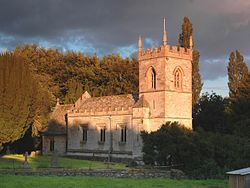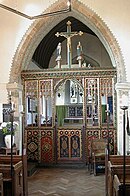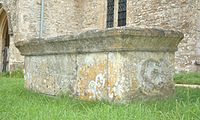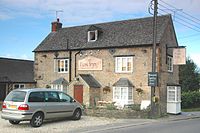Westcott Barton
| Westcott Barton | |
| Oxfordshire | |
|---|---|
 St Edward the Confessor, Westcott Barton | |
| Location | |
| Grid reference: | SP428256 |
| Location: | 51°55’37"N, 1°22’44"W |
| Data | |
| Population: | 244 (2011) |
| Post town: | Chipping Norton |
| Postcode: | OX7 |
| Dialling code: | 01869 |
| Local Government | |
| Council: | West Oxfordshire |
| Parliamentary constituency: |
Witney |
Westcott Barton, also written Wescot Barton or Wescote Barton, is a village on the River Dorn in the middle of Oxfordshire, sitting close by Middle Barton about seven miles east of Chipping Norton and about ten miles south of Banbury. The neighbouring parish is Steeple Barton, to which Middle Barton belongs.
The 2011 Census recorded the parish's population as 244
The village has a church and an early 18th-century public house, the Fox Inn.[1][2]
Parish church
There is archaeological evidence that by at least the 11th century there was an Anglo-Saxon stone church at Westcott Barton, which was originally dedicated to St Edmund the Martyr. In the 11th century the nave was extended westwards and in about the middle of the 12th century the south aisle was added. It has a two-bay arcade and a tomb recess,[3] both of which are Norman.[4] The chancel arch is in a transitional style from Norman to Early Gothic.[5] The church's dedication was changed from St Edmund to St Edward the Confessor in 1238.[6] In the 14th and 15th centuries the chancel and north wall of the nave were rebuilt, the west tower and battlemented south porch were built[3] and the wooden rood screen was installed, all in Perpendicular Gothic style.[4] However, in about 1520 the chancel was reported to be in ruins.[3]
A west gallery was installed, presumably in the 18th century. In 1855–56 the gallery was removed and the church was restored under the direction of the Oxford Diocesan Architect George Edmund Street,[3] who also added the battlements to the nave parapet. The then Vicar, Rev. E.L. Lockyer, painted the screen[5] and the decorated patterns on the chancel and aisle arches. The current rood cross is a 19th-century Gothic Revival addition.[7] St Edward's is a Grade II* listed building.[5] In the churchyard just south of the church are a 15th-century tomb chest that has a quatrefoil at either end, and the base and steps of a late mediæval stone cross.[3]
Between 1180 and 1189 Alexander of Barton gave the church to the Benedictine Eynsham Abbey. In 1538, in the Dissolution of the Monasteries, the Abbey surrendered all its property to the Crown, which in 1557 sold the advowson of Westcott Barton to a secular buyer. In 1960 the benefice was merged with that of Steeple Barton, and in 1977 this united benefice was combined with the parishes of Duns Tew and Sandford St Martin.[3]
History
As its name implies, Westcott Barton developed as a secondary settlement of the original village of Barton, which is now called Steeple Barton. By the time of the Norman Conquest it had its own manor and parish church, but it remained the smaller and less populous parish and as a result in the Middle Ages it was occasionally called Little Barton.[3] Before the Norman Conquest, Leofwine of Barton held the manor of Westcott Barton along with those of Dunthrop, Duns Tew and Little Tew.
The Domesday Book records that by 1086 Gilbert de Magminot, Bishop of Lisieux, held Westcott Manor. It remained in his family until early in the 12th century. In 1483 it is recorded that the Crown held the manor as part of the Earldom of Hereford; and early in the 17th century it was part of the Duchy of Lancaster, by way of the Earldom of Hereford.
In 1638 Westcott Barton manor was assessed at 12 yardlands.[3]
The village used to be clustered immediately around the parish church. Earthworks indicating the sites of buildings survive to the west, south and east of the churchyard.[8] However, the modern village is 250 yards east of the church, contiguous now with Middle Barton village in the Steeple Barton parish.[8]
The agricultural lands of Steeple Barton and Westcott Barton were worked as a single field system. A single Inclosure Act for both was implemented in 1796.[3] The main road between Bicester and Enstone (now the B4030) traverses the parish from east to west. It was turnpiked from 1793 to 1876.[3]
Outside links
| ("Wikimedia Commons" has material about Westcott Barton) |
References
- ↑ National Heritage List 1052492: The Fox Public House (Grade II listing)
- ↑ The Fox Inn
- ↑ 3.0 3.1 3.2 3.3 3.4 3.5 3.6 3.7 3.8 3.9 Crossley 1983, pp. 75–81
- ↑ 4.0 4.1 Sherwood & Pevsner 1974, p. 832.
- ↑ 5.0 5.1 5.2 National Heritage List 1285863: Church of St Edward the Confessor (Grade II* listing)
- ↑ Anonymous, undated, page 8
- ↑ Anonymous, undated, page 6
- ↑ 8.0 8.1 Chambers 1979, p. 99.
- Anonymous (n.d.). The Parish Church of St Edward the Confessor Wescote Barton. Westcott Barton: (eight-page leaflet of history of church).
- Chambers, R.A. (1979). "Excavations at Westcote Barton Parish Church, 1977". Oxoniensia (Oxfordshire Architectural and Historical Society) XLIV: 99–101.
- A History of the County of Oxford - Volume 11 pp 75-81: Parishes: Westcott Barton (Victoria County History)
- Nikolaus Pevsner: The Buildings of England: Oxfordshire, 1974 Penguin Books ISBN 978-0-300-09639-2




